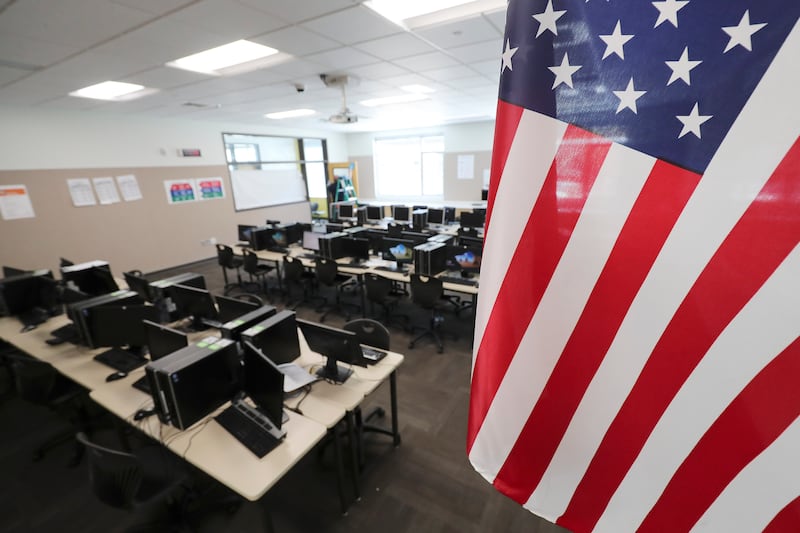SALT LAKE CITY — Two of the nation’s leading experts on COVID-19 have urged Utah schools to deploy rapid testing of school teachers and resume in-classroom learning.
Sen. Todd Weiler, R-Woods Cross, addressed the Salt Lake City Board of Education Tuesday, sharing what he learned in a briefing from Senate President Stuart Adams, who along with other state leaders met over the weekend with White House coronavirus task force coordinator Dr. Deborah Birx and Dr. Robert Redfield, director of the Centers for Disease Control and Prevention.
Birx and Redfield told state leaders that COVID-19 primarily spreads in communities, Weiler said.
“It’s not occurring in the schools and this is what we’re finding in Utah,” he said.
“We’re often told that we need to follow the science. This is from the CDC and Dr. Fauci’s, his office, telling us ‘Get your kids back in school.’”
Weiler also conveyed a message from Adams to the Salt Lake board and school district, the only district in Utah to start the school year solely in remote mode, as it remains except for special education and other students who need individualized attention.
“He said we need to get the kids back in the schools. So I would just ask the school board to follow the guidance from the public health experts. I believe that kids need to be in school, that they do best in school,” Weiler said.
Interim Superintendent Larry Madden proposed that elementary school students start returning to in-person learning in phases starting in January, starting with pre-kindergarten and kindergarteners and bringing in grades 2-6 in subsequent weeks. The district would continue to offer remote learning options for families who do not feel safe returning to school. Secondary students would stay in remote mode.
The board took no action on Madden’s proposal. Board member Katherine Kennedy said she was not prepared to make a decision, and the recent surge in COVID-19 cases indicates returning is not safe.
Board members said a survey is needed to determine parental preferences with respect to in-person learning and remote learning moving forward. Administrators have been preparing a survey and are aiming for 100% response, they said.
“Without that information, it’s hard to get to nuts and bolts of the (return to school) plan,” Madden said.
Kennedy said it is also important to understand teachers’ preferences. Other board members want updated information on the district’s return-to-school metrics.
Board member Mike Nemelka said there is an urgency to return to schools, especially for working families.
“You’ve got the prime time coming up for them to work in December and November. If we wait until January, we’re going to be just as bad off as they are right now,” he said.
He said the board has been talking about its options since August but needs to make a decision that returns students to school.
“We can keep these children and teachers safe. They’re doing it all through Salt Lake County, Davis County, all over the state,” Nemelka said.
Nemelka proposed a return of elementary school students in November and secondary students in January, but his motion failed.
“We got to quit pushing it off and make a decision, for heaven’s sake. These people want to know what’s going to happen,” he said.
Board President Melissa Ford said her highest priority is that parents have options.
Nearly 20 parents, students and educators addressed the board, most of them urging the school district to stick with remote learning.
But some parents said online learning doesn’t work for students, some of whom are providing child care for younger siblings while their parents work.
“Right now there’s an 8-year-old that takes care of a 3-month-old baby in his home, and he is expected to go to school,” said Lacey Skippshola, whose children are enrolled in Salt Lake schools.
Skippshola said her own children are in elementary, middle and high schools.
“My older kids are watching my younger kids because I have to feed them,” she said.
Jose Escabi, the parent of two children in the school district, said he is an engineer and his profession relies on data to make decisions.
“I’m asking you to not open schools for in-person learning because it just doesn’t support it. This may not be the easiest thing for kids right now mentally, but at least they will live,” he said.
Abby Nelson, a fifth-grade teacher at Whittier Elementary School, asked the board what logistical supports would be available should the district return to in-person learning.
“I know that the emotions are running high. People are so fatigued and so worn out. But here’s my question: If you vote for in-person instruction, what are the logistical supports? Are you going to provide substitutes?” she asked.
The issue is “very personal” to her, she said, explaining that two of her family members died of COVID-19 and her sister is recovering from it, although it is “touch and go.”
Nelson said she wants to be with her students but she needs assurances of the steps the district will take to ensure the return to classrooms can be done safely.


